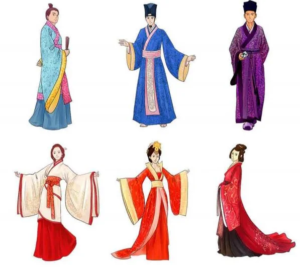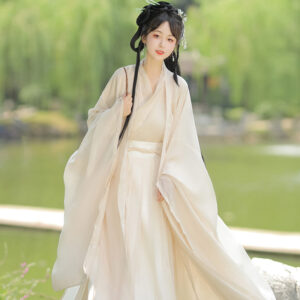

The evolution of Qing Dynasty Hanfu was influenced by a variety of factors, including political mandates, cultural fusion, technological advancements, and socio-economic changes. Here’s a detailed exploration of these influences:
1. Political Mandates
- Manchu Influence: The Manchu conquest in 1644 brought significant changes to Hanfu. As the ruling class, the Manchu integrated their distinct sartorial elements into traditional Han clothing. This led to the emergence of garments like the Qipao (Cheongsam), which became symbols of Chinese femininity while reflecting Manchu political dominance.
- Dress Regulations: The Qing government established strict dress codes that dictated what different social classes could wear. These regulations reinforced social hierarchies and political control. For example, only the emperor could wear dragon motifs, while lower officials had to adhere to simpler designs.
2. Cultural Fusion
- Integration of Styles: The blending of Manchu and Han clothing styles created new forms of attire that symbolized cultural synthesis. The adaptation of traditional Hanfu to include Manchu elements marked a significant shift in fashion during this period.
- Regional Influences: Local customs and practices also played a role in shaping Hanfu designs. Ethnic minorities contributed unique styles, resulting in a diverse array of garments across different regions.
3. Technological Advancements
- Fabric Production: Advances in textile production allowed for a wider variety of fabrics and patterns. While silk remained dominant, other materials like cotton and wool became more prevalent, particularly in regions where they were abundant.
- Tailoring Techniques: Improved tailoring methods facilitated the creation of more structured and fitted garments, moving away from the flowing silhouettes characteristic of earlier Hanfu styles.
4. Socio-Economic Factors
- Class Distinctions: Clothing during the Qing Dynasty was closely tied to social identity. Wealthier individuals wore more elaborate garments made from luxurious fabrics, while commoners had simpler attire. This distinction was reinforced by sumptuary laws that regulated clothing based on social rank.
- Urbanization: As cities grew, fashion trends evolved to reflect urban lifestyles. This shift further influenced Hanfu designs, leading to styles that were more practical for daily life while still retaining cultural significance.
Summary Table: Influences on Qing Dynasty Hanfu Evolution
| Influence Type | Description |
|---|---|
| Political Mandates | Manchu rulers integrated their styles; strict dress codes reinforced social hierarchies |
| Cultural Fusion | Blending of Manchu and Han styles; regional influences added diversity |
| Technological Advancements | Improved fabric production and tailoring techniques enhanced garment design |
| Socio-Economic Factors | Class distinctions dictated clothing styles; urbanization influenced practical adaptations |
Conclusion
The evolution of Qing Dynasty Hanfu reflects a complex interplay of political power, cultural integration, technological progress, and socio-economic dynamics. These influences not only transformed the aesthetics of Hanfu but also embedded deeper meanings related to identity and status within Chinese society during this pivotal era.
Share this post
Facebook
Twitter
LinkedIn
Pinterest
Recent Posts


What were the key features of Hanfu during the Tang Dynasty?
October 24, 2024

How did Hanfu styles vary during different Chinese dynasties?
October 24, 2024

What accessories are typically worn with Hanfu?
October 24, 2024

How do you choose the right Hanfu for different seasons?
October 24, 2024

Newsletter
Subscribe for our monthly newsletter to stay updated
Popular Categories
Related Post
Sed aliquam, tortor et sodales malesuada, lorem leo luctus tellus, quis interdum eros nibh in nunc. Cras dignissim malesuada, lorem leo luctus

What are the winter hanfu called?
October 24, 2024

What were the key features of Hanfu during the Tang Dynasty?
October 24, 2024

How did Hanfu styles vary during different Chinese dynasties?
October 24, 2024

What accessories are typically worn with Hanfu?
October 24, 2024

